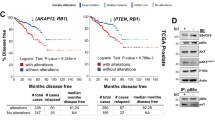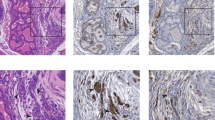Abstract
PIM1 kinase and MYC are commonly co-expressed in human prostate cancer and synergize to induce rapidly progressing prostate cancer in mouse models. Deficiency of the Pim kinase genes is well tolerated in vivo, suggesting that PIM1 inhibition might offer an attractive therapeutic modality for prostate cancer, particularly for MYC-expressing tumors. Here we examine the molecular consequences of Pim1 and MYC overexpression in the prostate as well as the effects of depleting Pim1 in prostate carcinoma cells with high levels of MYC. Overexpression of Pim1 in the mouse prostate induces several pro-tumorigenic genetic programs including cell cycle genes and Myc-regulated genes before the induction of any discernible pathology. Pim1 depletion by RNA interference in mouse and human prostate cancer cells decreased cellular proliferation, survival, Erk signaling and tumorigenicity even when MYC levels were not significantly altered. These results indicate that PIM1 may be necessary to maintain tumorigenicity, and further support efforts aimed at developing PIM1 inhibitors for prostate cancer therapy.
This is a preview of subscription content, access via your institution
Access options
Subscribe to this journal
Receive 50 print issues and online access
$259.00 per year
only $5.18 per issue
Buy this article
- Purchase on Springer Link
- Instant access to full article PDF
Prices may be subject to local taxes which are calculated during checkout





Similar content being viewed by others
References
Abdulkadir SA, Carbone JM, Naughton CK, Humphrey PA, Catalona WJ, Milbrandt J . (2001). Frequent and early loss of the EGR1 corepressor NAB2 in human prostate carcinoma. Hum Pathol 32: 935–939.
Abdulkadir SA, Carvalhal GF, Kaleem Z, Kisiel W, Humphrey PA, Catalona WJ et al. (2000). Tissue factor expression and angiogenesis in human prostate carcinoma. Hum Pathol 31: 443–447.
Aho TL, Sandholm J, Peltola KJ, Mankonen HP, Lilly M, Koskinen PJ . (2004). Pim-1 kinase promotes inactivation of the pro-apoptotic Bad protein by phosphorylating it on the Ser112 gatekeeper site. FEBS Lett 571: 43–49.
Berns A, Mikkers H, Krimpenfort P, Allen J, Scheijen B, Jonkers J . (1999). Identification and characterization of collaborating oncogenes in compound mutant mice. Cancer Res 59: 1773s–1777s.
Burton GR, Nagarajan R, Peterson CA, McGehee Jr RE . (2004). Microarray analysis of differentiation-specific gene expression during 3T3-L1 adipogenesis. Gene 329: 167–185.
Chen J, Kobayashi M, Darmanin S, Qiao Y, Gully C, Zhao R et al. (2009a). Hypoxia-mediated up-regulation of Pim-1 contributes to solid tumor formation. Am J Pathol 175: 400–411.
Chen LS, Redkar S, Bearss D, Wierda WG, Gandhi V . (2009b). Pim kinase inhibitor, SGI-1776, induces apoptosis in chronic lymphocytic leukemia cells. Blood 114: 4150–4157.
Chen WW, Chan DC, Donald C, Lilly MB, Kraft AS . (2005). Pim family kinases enhance tumor growth of prostate cancer cells. Mol Cancer Res 3: 443–451.
Davis AC, Wims M, Spotts GD, Hann SR, Bradley A . (1993). A null c-myc mutation causes lethality before 10.5 days of gestation in homozygotes and reduced fertility in heterozygous female mice. Genes Dev 7: 671–682.
Grundler R, Brault L, Gasser C, Bullock AN, Dechow T, Woetzel S et al. (2009). Dissection of PIM serine/threonine kinases in FLT3-ITD-induced leukemogenesis reveals PIM1 as regulator of CXCL12-CXCR4-mediated homing and migration. J Exp Med 206: 1957–1970.
Gu JJ, Wang Z, Reeves R, Magnuson NS . (2009). PIM1 phosphorylates and negatively regulates ASK1-mediated apoptosis. Oncogene 28: 4261–4271.
Hu XF, Li J, Vandervalk S, Wang Z, Magnuson NS, Xing PX . (2009). PIM-1-specific mAb suppresses human and mouse tumor growth by decreasing PIM-1 levels, reducing Akt phosphorylation, and activating apoptosis. J Clin Invest 119: 362–375.
Jager J, Gremeaux T, Gonzalez T, Bonnafous S, Debard C, Laville M et al. (2010). Tpl2 kinase is upregulated in adipose tissue in obesity and may mediate interleukin-1beta and tumor necrosis factor-{alpha} effects on extracellular signal-regulated kinase activation and lipolysis. Diabetes 59: 61–70.
Kim J, Roh M, Abdulkadir SA . (2010). Pim1 promotes human prostate cancer cell tumorigenicity and c-MYC transcriptional activity. BMC Cancer 10: 248.
Kolch W . (2000). Meaningful relationships: the regulation of the Ras/Raf/MEK/ERK pathway by protein interactions. Biochem J 351 (Part 2): 289–305.
Laird PW, van der Lugt NM, Clarke A, Domen J, Linders K, McWhir J et al. (1993). In vivo analysis of Pim-1 deficiency. Nucleic Acids Res 21: 4750–4755.
Leiblich A, Cross SS, Catto JW, Pesce G, Hamdy FC, Rehman I . (2007). Human prostate cancer cells express neuroendocrine cell markers PGP 9.5 and chromogranin A. Prostate 67: 1761–1769.
Magnuson NS, Wang Z, Ding G, Reeves R . (2010). Why target PIM1 for cancer diagnosis and treatment? Future Oncol 6: 1461–1478.
Mikkers H, Nawijn M, Allen J, Brouwers C, Verhoeven E, Jonkers J et al. (2004). Mice deficient for all PIM kinases display reduced body size and impaired responses to hematopoietic growth factors. Mol Cell Biol 24: 6104–6115.
Mootha VK, Lindgren CM, Eriksson KF, Subramanian A, Sihag S, Lehar J et al. (2003). PGC-1alpha-responsive genes involved in oxidative phosphorylation are coordinately downregulated in human diabetes. Nat Genet 34: 267–273.
Morishita D, Katayama R, Sekimizu K, Tsuruo T, Fujita N . (2008). Pim kinases promote cell cycle progression by phosphorylating and down-regulating p27Kip1 at the transcriptional and posttranscriptional levels. Cancer Res 68: 5076–5085.
Mumenthaler SM, Ng PY, Hodge A, Bearss D, Berk G, Kanekal S et al. (2009). Pharmacologic inhibition of Pim kinases alters prostate cancer cell growth and resensitizes chemoresistant cells to taxanes. Mol Cancer Ther 8: 2882–2893.
Qian KC, Wang L, Hickey ER, Studts J, Barringer K, Peng C et al. (2005). Structural basis of constitutive activity and a unique nucleotide binding mode of human Pim-1 kinase. J Biol Chem 280: 6130–6137.
Roh M, Gary B, Song C, Said-Al-Naief N, Tousson A, Kraft A et al. (2003). Overexpression of the oncogenic kinase Pim-1 leads to genomic instability. Cancer Res 63: 8079–8084.
Shah N, Pang B, Yeoh KG, Thorn S, Chen CS, Lilly MB et al. (2008). Potential roles for the PIM1 kinase in human cancer—a molecular and therapeutic appraisal. Eur J Cancer 44: 2144–2151.
Subramanian A, Tamayo P, Mootha VK, Mukherjee S, Ebert BL, Gillette MA et al. (2005). Gene set enrichment analysis: a knowledge-based approach for interpreting genome-wide expression profiles. Proc Natl Acad Sci USA 102: 15545–15550.
Tusher VG, Tibshirani R, Chu G . (2001). Significance analysis of microarrays applied to the ionizing radiation response. Proc Natl Acad Sci USA 98: 5116–5121.
Verbeek S, van Lohuizen M, van der Valk M, Domen J, Kraal G, Berns A . (1991). Mice bearing the E mu-myc and E mu-pim-1 transgenes develop pre-B-cell leukemia prenatally. Mol Cell Biol 11: 1176–1179.
Wang J, Kim J, Roh M, Franco OE, Hayward SW, Wills ML et al. (2010). Pim1 kinase synergizes with c-MYC to induce advanced prostate carcinoma. Oncogene 29: 2477–2487.
Zhang Y, Wang Z, Li X, Magnuson NS . (2008). Pim kinase-dependent inhibition of c-Myc degradation. Oncogene 27: 4809–4819.
Zippo A, De Robertis A, Serafini R, Oliviero S . (2007). PIM1-dependent phosphorylation of histone H3 at serine 10 is required for MYC-dependent transcriptional activation and oncogenic transformation. Nat Cell Biol 9: 932–944.
Acknowledgements
We thank Drs Robert Matusik, Simon Hayward, Vito Quaranta, Xiuping Yu and Fritz Parl for helpful discussions. Micrographs were taken from Cell Imaging Core at Vanderbilt University Medical Center. This work was supported by Grant RO1CA123484 from the NCI to SAA. while DG is supported by R01CA152601 from the NCI and BC093803 from the DOD.
Author information
Authors and Affiliations
Corresponding author
Ethics declarations
Competing interests
The authors declare no conflict of interest. The funders had no role in study design, data collection and analysis, decision to publish, or preparation of the manuscript.
Additional information
Supplementary Information accompanies the paper on the Oncogene website
Rights and permissions
About this article
Cite this article
Wang, J., Anderson, P., Luo, W. et al. Pim1 kinase is required to maintain tumorigenicity in MYC-expressing prostate cancer cells. Oncogene 31, 1794–1803 (2012). https://doi.org/10.1038/onc.2011.371
Received:
Revised:
Accepted:
Published:
Issue Date:
DOI: https://doi.org/10.1038/onc.2011.371
Keywords
This article is cited by
-
UM171 cooperates with PIM1 inhibitors to restrict HSC expansion markers and suppress leukemia progression
Cell Death Discovery (2022)
-
The SUMO pathway in pancreatic cancer: insights and inhibition
British Journal of Cancer (2021)
-
Rebelled epigenome: histone H3S10 phosphorylation and H3S10 kinases in cancer biology and therapy
Clinical Epigenetics (2020)
-
PIM kinase inhibition: co-targeted therapeutic approaches in prostate cancer
Signal Transduction and Targeted Therapy (2020)
-
PIM kinases mediate resistance of glioblastoma cells to TRAIL by a p62/SQSTM1-dependent mechanism
Cell Death & Disease (2019)



